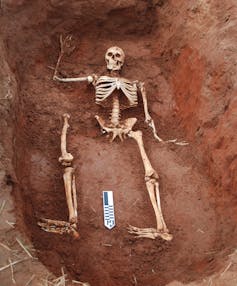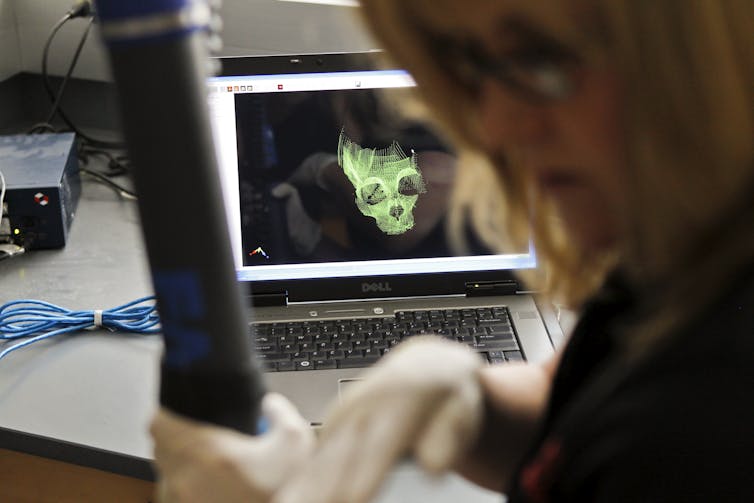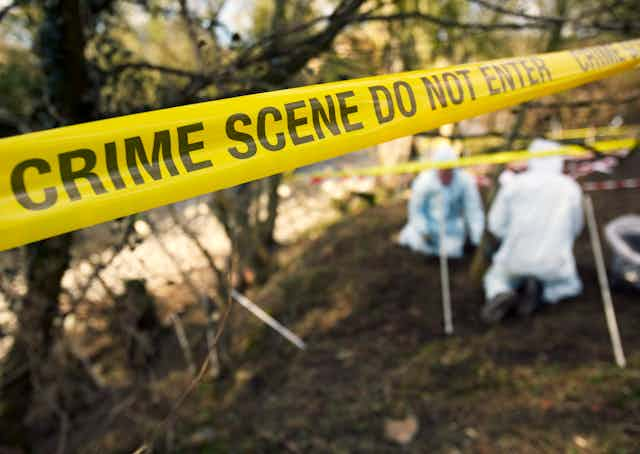A seasoned deer hunter is shocked when his hound dog trots up with a human femur clenched between its teeth. A woman veers off her normal urban walking path and happens upon a human skull. New property owners commission a land survey that reveals a set of human remains just below a pile of leaves.
These examples are real cases handled by coroners’ offices where we have assisted as forensic anthropologists.
What happens after someone inadvertently discovers a human body? How are human skeletal remains identified? It can be a major effort, requiring collaboration across law enforcement, forensic anthropologists and death investigators to uncover the identities of the unidentified dead and help bring justice to people who were victims of foul play.
There are nearly 15,000 open cases in the United States involving unidentified people, according to the Department of Justice’s National Missing and Unidentified Persons System, a centralized database and resource for unidentified, missing and unclaimed people. This is an underestimate, though, because there is no universal reporting requirement across agencies. Many practicing forensic anthropologists work hard to alleviate what’s routinely referred to as the “nation’s silent mass disaster” – the crisis of so many missing and unidentified individuals.
A specialized branch of anthropology
Anthropology is the holistic study of human culture, environment and biology across time and space. Biological anthropology focuses on the physiological aspects of people and our nonhuman primate relatives. It considers topics ranging from the evolutionary history of our species to the analysis of ancient and modern skeletal remains. Forensic anthropology is a further subspecialty that analyzes skeletal remains of the recently deceased within a legal setting.

Forensic anthropologists are trained in identifying human skeletal remains. They use scientific techniques to identify deceased people whose faces are unrecognizable – often referred to as “Jane and John Does.” Forensic anthropologists’ skills allow them to interpret from skeletons the trauma and disease a person suffered in life, as well as estimate when that person died.
One of us is employed as a postdoctoral research fellow as well as a forensic anthropologist and deputy coroner through a county coroner’s office; the other is a university professor who responds to local forensic scenes on an as-needed, consulting basis. The realities of forensic anthropology casework are often misrepresented by crime and mystery movies and shows, but our positions reflect how a lot of practicing forensic anthropologists are employed in the United States.
Outside of local work, forensic anthropologists travel to sites of political violence, mass disasters such as the tragedies of 9/11 or the collapse of the Surfside condo building in Miami, and events like the devastating fires in Maui. Normal procedures for handling deaths can quickly become overwhelmed during crises; burial of the dead can take priority over identification, as has been occurring in Gaza.
Scientific tools to identify the unidentified
The complex decomposition process begins as soon as someone dies. Environment, weather, trauma, clothing and location of the death, among other variables, can all complicate how quickly a body decomposes. In cases of advanced decomposition or extreme circumstances such as fires or building collapses, the deceased may no longer be recognizable. That’s a situation in which local law enforcement might want to contact a forensic anthropologist, if possible, to collaborate on figuring out the person’s identity and possibly the circumstances around their death.
A forensic anthropologists’ primary toolkit involves observing subtle variations in features of the skeleton to create a biological profile: an estimation of the individual’s age at death, biological sex, height during life and any potentially unique skeletal characteristics, such as healed trauma or tooth loss that may have been visible during life. Forensic anthropologists assess the entire skeleton, with an emphasis on the skull, pelvis and long bones.
Information learned from the skeleton is then uploaded to the National Missing and Unidentified Persons System so it can be compared with missing person records. The goal is to develop leads on the person’s identity. An estimated time of death can also provide a useful point of comparison.
For example, consider a case in upstate South Carolina that one of us assisted on. Human remains were discovered in someone’s yard after a dog dragged several bones out of a creek. Our assessment revealed that the size and shape of the bones were consistent with this Jane Doe being a middle-aged woman. This information allowed local investigators to quickly narrow the pool of missing people in the area who fit that description. Ultimately, they were able to identify this unknown person.
Missing person records can vary at the county and state levels, though, and not all missing people are even reported. These bureaucratic challenges can complicate our attempts to match up information learned from the skeleton with the database.

In the absence of a match, the next step in the identification process can involve a forensic facial reconstruction. Based on the forensic anthropologist’s assessment, along with any clothing found associated with the decedent, a forensic artist will create a 2D or sometimes 3D facial reconstruction. Law enforcement can release the image to the public through a press release, which may generate leads about who the person was.
DNA can provide other valuable clues, but submitting samples for analysis can be cost-prohibitive. If funding and resources are available, we submit samples from bone or teeth to a lab that can then generate a genetic sequence from the skeletal remains.
Even with a clear sequence, though, the unknown DNA sample must be matched either to a sample collected during life or from a close relative in order to be useful for determining identity. It can take weeks, months or even years to get the unknown sequence back and compare it with known individuals. If no match is found, genetic genealogy may suggest leads through potentially related individuals – but this investigative field is still emerging.
In each step toward identification, there are many logistical and bureaucratic barriers that contribute to an enormous backlog of unidentified people in county morgues and coroners’ offices. Many cold cases remain unsolved for decades, and the process is further compounded in cases involving undocumented people. Despite these hurdles, forensic anthropologists remain committed to returning names to the unidentified.

